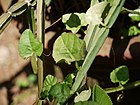Note: This is a project under development. The articles on this wiki are just being initiated and broadly incomplete. You can Help creating new pages.
Difference between revisions of "Cissus quadrangularis - Asthisamharaka"
(→References) |
(→List of Ayurvedic medicine in which the herb is used) |
||
| Line 47: | Line 47: | ||
==List of Ayurvedic medicine in which the herb is used== | ==List of Ayurvedic medicine in which the herb is used== | ||
| + | * [[Lakshadi guggul]] | ||
| + | * [[Panchajeeraka Gudam]] | ||
| + | <ref name="Ayurvedic preparations"/> | ||
==Where to get the saplings== | ==Where to get the saplings== | ||
Revision as of 09:59, 5 June 2019
Asthisamharaka is a perennial plant of the Grape family. It is also known as veldt grape, devil's backbone, adamant creeper, cissus quadrangularis, hadjod and pirandai. The plant grows throughout India, especially, in gotter regions and in Sri Lanka.
Contents
- 1 Uses
- 2 Parts Used
- 3 Chemical Composition
- 4 Common names
- 5 Properties
- 6 Habit
- 7 Identification
- 8 List of Ayurvedic medicine in which the herb is used
- 9 Where to get the saplings
- 10 Mode of Propagation
- 11 How to plant/cultivate
- 12 Commonly seen growing in areas
- 13 Photo Gallery
- 14 References
- 15 External Links
Uses
Bone Fracture, Low bone mineral density, Osteoporosis, Osteoarthritis, Joint pains, Hyperuricemia, Diarrhea, Rickets, Obesity, Internal Bleeding, Hemorrhoid, Improve digestion, Syphilis, Menorrhagia, Pyorrhea[1]
Parts Used
Stem.
Chemical Composition
Two new iridoids 6-O-[2,3-dimethoxy]-trans-cinnamoyl catalpol and 6-O-meta-methoxy-benzoyl catalpol along with a known iridoid picroside 1, two stilbenes quadrangularin A and pallidol, quercitin, quercitrin, beta-sitosterol and beta-sitosterol glycoside were isolated from Cissus quadrangularis Linn.
Common names
| Language | Common name |
|---|---|
| Kannada | Saduballi |
| Hindi | Harshankar |
| Malayalam | changalam paranda |
| Tamil | pindai, perandai |
| Telugu | nalleru |
| Marathi | NA |
| Gujarathi | NA |
| Punjabi | NA |
| Kashmiri | NA |
| Sanskrit | Asthisamharaka |
| English | Veld Grape |
Properties
Reference: Dravya - Substance, Rasa - Taste, Guna - Qualities, Veerya - Potency, Vipaka - Post-digesion effect, Karma - Pharmacological activity, Prabhava - Therepeutics.
Dravya
Rasa
Madhura (Sweet)
Guna
Laghu (Light), Ruksha (Dry)
Veerya
Ushna (Hot)
Vipaka
Katu (Pungent)
Karma
Prabhava
Habit
Identification
Leaf
| Kind | Shape | Feature |
|---|---|---|
| simple | Ovate-suborbicular to reniform | Leaf Apex is Round, Leaf Base is Round and Leaf Margin is Serrate |
Flower
| Type | Size | Color and composition | Stamen | More information |
|---|---|---|---|---|
| umbellate cymes | 10–15 cm long | greenish-yellow, red tipped | Flowering throughout the year |
Fruit
| Type | Size | Mass | Appearance | Seeds | More information |
|---|---|---|---|---|---|
| A globose berry | fruit is apiculate and green turning red when ripe | seed smooth | Fruiting throughout the year | {{{6}}} |
Other features
List of Ayurvedic medicine in which the herb is used
Where to get the saplings
Mode of Propagation
How to plant/cultivate
Cuttings with one or few segmengts can be planted. They require full sun and very warm conditions to thrive. A plant of drier to arid regions, mainly in the lowland tropics and frost-free subtropics, though it can also be found at elevations over 2,000 metres [4]
Commonly seen growing in areas
Lowland tropics, Subtropical area.
Photo Gallery
References
- ↑ "Cissus Uses"
- ↑ "Morphology"
- ↑ Cite error: Invalid
<ref>tag; no text was provided for refs namedAyurvedic preparations - ↑ "Cultivation Details"
External Links
- Pages with reference errors
- Ayurvedic Herbs known to be helpful to treat Bone Fracture
- Ayurvedic Herbs known to be helpful to treat Low bone mineral density
- Ayurvedic Herbs known to be helpful to treat Osteoporosis
- Ayurvedic Herbs known to be helpful to treat Osteoarthritis
- Ayurvedic Herbs known to be helpful to treat Joint pains
- Ayurvedic Herbs known to be helpful to treat Hyperuricemia
- Ayurvedic Herbs known to be helpful to treat Diarrhea
- Ayurvedic Herbs known to be helpful to treat Rickets
- Ayurvedic Herbs known to be helpful to treat Obesity
- Ayurvedic Herbs known to be helpful to treat Internal Bleeding
- Ayurvedic Herbs known to be helpful to treat Hemorrhoid
- Ayurvedic Herbs known to be helpful to treat Improve digestion
- Ayurvedic Herbs known to be helpful to treat Syphilis
- Ayurvedic Herbs known to be helpful to treat Menorrhagia
- Ayurvedic Herbs known to be helpful to treat Pyorrhea
- Herbs with Stem used in medicine
- Herbs with common name in Kannada
- Herbs with common name in Hindi
- Herbs with common name in Malayalam
- Herbs with common name in Tamil
- Herbs with common name in Telugu
- Herbs with common name in Sanskrit
- Herbs with common name in English
- Habit - Scandent shrub
- Index of Plants which can be propagated by Cuttings
- Herbs that are commonly seen in the region of Lowland tropics
- Herbs that are commonly seen in the region of Subtropical area
- Herbs
- Vitaceae





